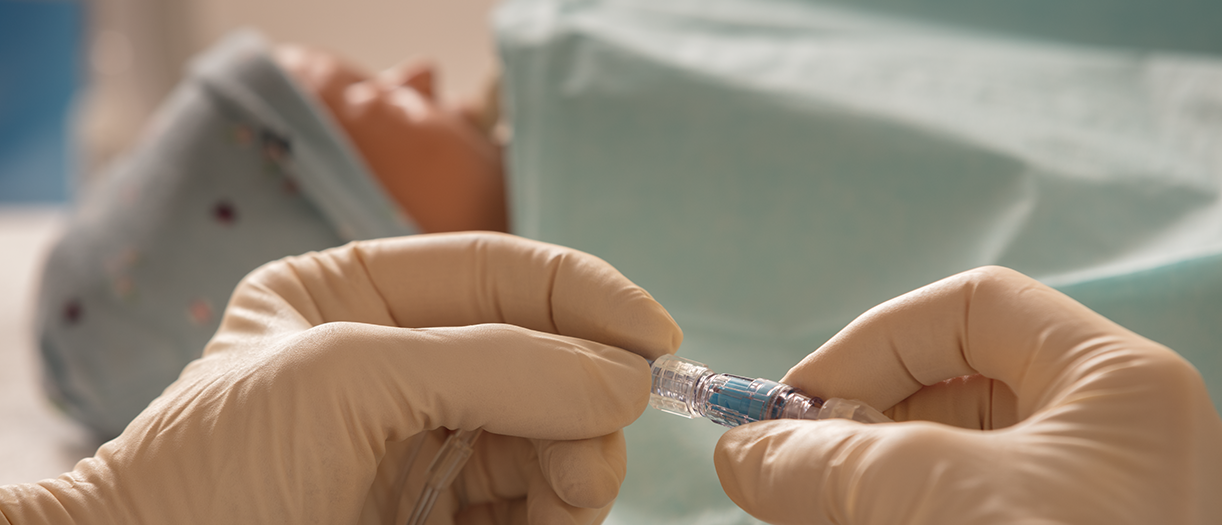12 practice guidelines for needleless connector best practice
Used widely in acute care, needleless connectors (NCs) are designed to ensure patient and healthcare worker safety1–3.
Focus on risks to patient safety
Catheter-related bloodstream infections (CRBSIs)
CRBSIs are one of the most frequent, deadly and expensive complications of central venous catheters4. Central venous catheters have a higher risk of catheter-related infections than any other type of medical device4.
More on this topic: The real cost of catheter-related bloodstream infections
Occlusion
Occlusion is one of the five most frequent reasons for peripheral IV catheter (PIVC) failure5. It can be caused by mechanical obstruction such as from kinking of the catheter, from catheter migration into a “dead-end” position within the vessel wall or tissue without frank infiltration/extravasation or from thrombosis of the catheter and/or surrounding vessel5. Blood reflux can also play a significant role in thrombotic catheter occlusion2.
Incidence of occlusion ranges from 2.5% to 32.7%5.
Focus on risks to healthcare worker safety
Needlestick injuries
Needlestick injuries continue to affect healthcare workers (HCWs). Commonly affected populations are doctors, nurses and medical/nursing students. Studies have shown that of all occupational exposures, 35% occur among persons in training and 27% among experienced nurses6.
Underreporting is a problem with only 9–38% of healthcare workers declaring their injuries7. The occurrence of needlestick injuries is most frequent among HCWs having close clinical contact with patients or patient specimens7.
Needleless connectors: an essential device in your vascular access toolkit
NCs offer the possibility of connecting administration sets or syringes to vascular access devices (VADs) by eliminating the use of needles8. Along with needlestick injury prevention, these devices are also designed to help prevent IV catheter-related complications9.
The International Nosocomial Infection Control Consortium (INICC) issued Care Bundles to Prevent Central and Peripheral Line-Related Bloodstream Infections9.
To help prevent IV catheter-related complications9:
- Use a luer-lock mechanism to ensure a secure junction when attaching the NC to a VAD or access site
- Don’t use three-way stopcocks as IV connection devices
- Disinfect NCs before inserting them into each VAD
- Use aseptic technique when changing NCs
- Only access NCs with a sterile device
- Consider using an extension set between the IV line and NC to reduce line manipulations
According to the 8th edition of the Infusion Therapy Standards of Practice, you should change needleless connectors8:
- When they are removed for any reason
- If blood or debris are found inside them
- Before drawing blood samples for culturing from the VAD (which should be avoided when using CVADs because these samples are more likely to produce false positives)
- If contamination occurs
- According to your healthcare facility’s policies, procedures and/or practice guidelines
- Per the manufacturers’ directions for use
More on this topic: BD webinar series explores vascular access best practice following release of the 8th edition of the Infusion Therapy Standards of Practice
Not all needleless connectors are alike
In 2014, a peer-reviewed meta-analysis by Tabak et al. found that NCs should contain the following safety features3:
- A smooth, solid access surface that can be effectively disinfected
- A visible fluid path allowing HCWs to verify flushing
- A straight fluid path
- Minimal internal complexity
- No blood reflux
- The ability to flush with saline solution alone
Needleless connectors: a preventative measure to help ensure patient and healthcare worker safety
Needleless connectors for intravenous systems can help protect healthcare workers from needlestick injuries. They may reduce the risk of exposure to blood-borne pathogens8. Positive displacement technologies and devices help reduce blood reflux at disconnection, which may lead to catheter occlusions8.
Tabak et al. found a 63% reduction in the risk of central line-related bloodstream infections (CLABSIs) with the MaxPlus™ Clear Needleless Connector when compared to other NCs used with central venous catheters3.
Williams et al. found a 55.1% reduction in occlusions with the MaxZero™ Needleless Connector when compared to other NCs used with central venous catheters in their observational study2.
To find out more about the technology behind these two needleless connectors, visit the webpage below.
References
- Tabak YP, Johannes RS, Sun X, Crosby CT, Jarvis WR. Innovative Use of Existing Public and Private Data Sources for Postmarketing Surveillance of Central Line-Associated Bloodstream Infections Associated With Intravenous Needleless Connectors. J Infus Nurs. 2016;39(5):328-335. doi:10.1097/NAN.0000000000000185
- Williams A. Catheter Occlusion in Home Infusion: The Influence of Needleless Connector Design on Central Catheter Occlusion. J Infus Nurs. 2018;41(1):52-57. doi:10.1097/NAN.0000000000000259
- Tabak YP, Jarvis WR, Sun X, Crosby CT, Johannes RS. Meta-analysis on central line-associated bloodstream infections associated with a needleless intravenous connector with a new engineering design. Am J Infect Control. 2014;42(12):1278-1284. doi:10.1016/j.ajic.2014.08.018
- Gahlot R, Nigam C, Kumar V, Yadav G, Anupurba S. Catheter-related bloodstream infections. Int J Crit Illn Inj Sci. 2014;4(2):162-167. doi:10.4103/2229-5151.134184
- Helm RE, Klausner JD, Klemperer JD, Flint LM, Huang E. Accepted but unacceptable: peripheral IV catheter failure. J Infus Nurs. 2015;38(3):189-203. doi:10.1097/NAN.0000000000000100
- Frijstein G, Hortensius J, Zaaijer HL. Needlestick injuries and infectious patients in a major academic medical centre from 2003 to 2010. Neth J Med. 2011;69(10):465-468.
- d’Ettorre G. Job stress and needlestick injuries: which targets for organizational interventions? Occup Med (Lond). Published online July 31, 2016. doi:10.1093/occmed/kqw110
- Gorski LA, Hadaway L, Hagle ME, et al. Infusion Therapy Standards of Practice, 8th Edition. J Infus Nurs. 2021;44(1S Suppl 1):S1-S224. doi:10.1097/NAN.0000000000000396
- International Nosocomial Infection Control Consortium (INICC). Care Bundles to Prevent Central and Peripheral Line-Related Bloodstream Infections. Published online January 1, 2017. Accessed September 7, 2022. https://tulussetiono.com/wp-content/uploads/2017/08/International-Nosocomial-Infection-Control-Consortium-INICC.pdf.pdf
This list of references to third-party peer-reviewed material and the sites they are hosted on are provided for your reference and convenience only, and do not imply any review or endorsement of the material or any association with their operators. The Third-Party References (and the Web sites to which they link) may contain information that is inaccurate, incomplete, or outdated. Your access and use of the Third Party Sites (and any Web sites to which they link) is solely at your own risk.


BD-72568




